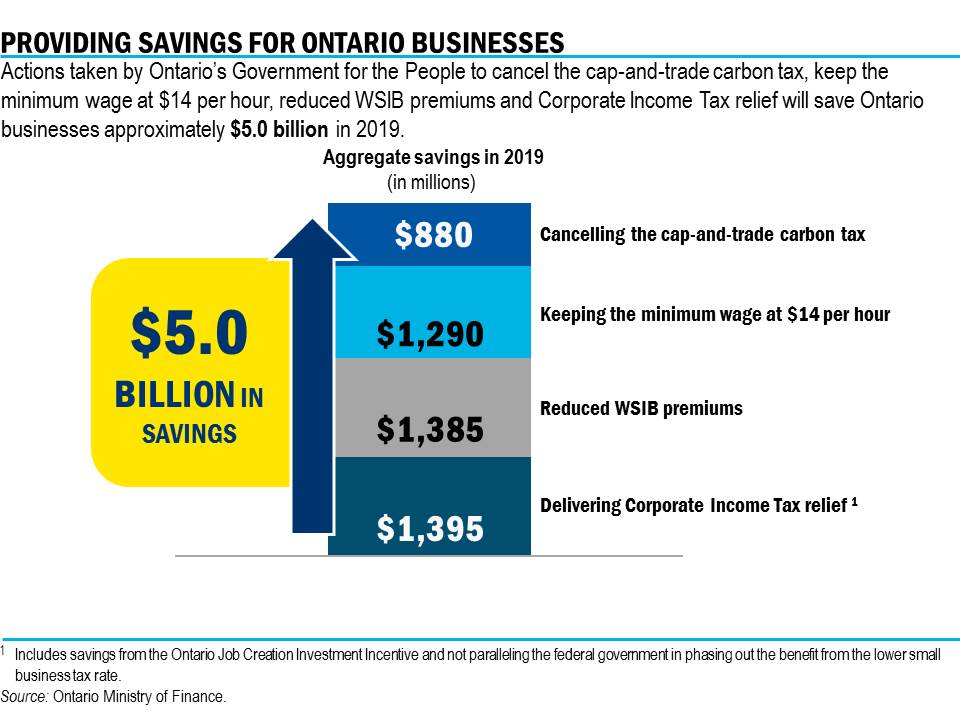The government is making Ontario open for business and open for jobs by cutting red tape, lowering business costs, creating apprenticeship opportunities and modernizing employment and training services in the province.

Ontario is creating an environment in which businesses can grow and hire more workers by:
- Providing $3.8 billion in provincial corporate income tax relief over six years through faster write-offs of capital investments under the Ontario Job Creation Investment Incentive.
- Proposing to cut red tape so smaller video game developers can apply for the Ontario Interactive Digital Media Tax Credit annually and get their tax credits faster.
- Reviewing how cultural media tax credits are administered to reduce the application backlog and help companies get their tax credits faster.
- Introducing the Open for Jobs Blueprint to modernize business support programs and make sure they are helping create jobs and grow the economy.
- Committing to cut the small business Corporate Income Tax rate by 8.7 per cent.
- Cutting red tape by 25 per cent by 2020. Once fully implemented, these changes are expected to provide Ontario businesses with over $400 million in ongoing savings on their compliance costs.
- Supporting the reduction of the Workplace Safety and Insurance Board’s (WSIB) average premium rate from $2.35 to $1.65 on every $100 of insurable payroll, effective January 1, 2019, which will save employers an estimated $1.45 billion in 2019.
- Enhancing consumer confidence by adopting title protection for financial planners and financial advisors to strengthen professionalism and improve efficiency and competitiveness of the financial services industry.
- Fostering economic growth and addressing unnecessary regulatory burden with a new five-point plan to create confidence in Ontario’s capital markets. The focus of this plan will be to strengthen investment in Ontario, promote competition and facilitate innovation.
- Launching targeted stakeholder consultations on industrial electricity pricing, with a view to helping Ontario businesses manage electricity costs.
- Fighting the federal government’s job-killing carbon tax, which will increase costs for automotive, manufacturing, transportation, mining and forestry activities, and put thousands of jobs at risk.
- Calling on the federal government to press the United States administration for immediate and permanent removal of its tariffs on Canadian steel and aluminum, and to ensure that no other trade impediments such as quotas are introduced.
The following chart illustrates a number of actions the government has already taken to reduce costs for businesses. Collectively these initiatives are estimated to save Ontario businesses $5 billion in 2019.

Connecting workers to jobs
Ontario is helping job seekers find jobs while helping employers hire the skilled workers they need by:
- Establishing programs that encourage the people of Ontario to enter skilled trades, get retrained and become aware of the benefits of good-paying jobs in the trades.
- Developing a one-window digital portal for apprentices.
- Making sure hard-working people get assistance to learn new skills when they lose a job through no fault of their own.
- Mobilizing Employment Ontario’s Rapid Re-employment and Training Services program to help General Motors and Fiat Chrysler workers regain employment as quickly as possible.
- Launching a new micro-credentials pilot this spring to provide people with the skills employers are seeking.
- Launching a pilot initiative to bring highly skilled immigrants to smaller communities.
Creating more choice and opportunities for students
The government is better aligning Ontario’s high-quality postsecondary education system to the job market while making it more sustainable, transparent and efficient by:
- Lowering tuition rates by 10 per cent for students at every publicly funded college and university starting in the 2019–20 school year, and freezing tuition fees for the 2020–21 school year.
- Letting students choose the non-essential fees they want to pay, which can add up to as much as $2,000 per academic year.
- Setting incentives for postsecondary institutions to provide the education and training students need to get jobs by tying 60 per cent of their funding to performance outcomes by the 2024–25 school year.
- Creating a new Northern Ontario Internship Program that will remove a requirement that internship applicants be recent university or college graduates, allowing new workers, people starting a new career, the unemployed and the underemployed to be eligible for the program.
Chart Description
Chart 1: Open for Business, Open for Jobs Strategy
This infographic describes the government’s Open for Business, Open for Jobs Strategy. The vision is stated as: connecting more workers to good jobs. This vision is supported by three pillars.
The first pillar is Open for Business, which includes lowering business costs, cutting red tape, supporting key sectors and regions and promoting Ontario internationally.
The second pillar is a skilled workforce, which includes helping employers attract skilled workers, aligning postsecondary funding with labour market outcomes, modernizing the apprenticeship and skilled trades system and reviewing employment and training services.
The third pillar is government supporting job creation and business investment, which includes ensuring sustainable public finances, creating confidence in capital markets and financial services, reducing red tape in the pension sector, investing in infrastructure – including broadband, and delivering quality health care, education and social services.
There are three outcomes of the strategy. The outcomes are increased employment, greater job creation driven by the private sector, and reducing regional disparities in jobs and growth.
Chart 2: Providing Savings for Ontario Businesses
This bar chart illustrates savings for Ontario businesses. Actions taken by Ontario’s Government for the People will save Ontario businesses approximately $5.0 billion in 2019. This includes combined savings from cancelling the cap-and-trade carbon tax ($880 million), keeping the minimum wage at $14 per hour ($1,290 million), reduced WSIB premiums ($1,385 million), and delivering corporate income tax relief ($1,395 million).
Notes: Estimated savings from delivering corporate income tax relief include savings from the Ontario Job Creation Investment Incentive and savings from not paralleling the federal government in phasing out the benefit from the lower small business tax rate.
Source: Ontario Ministry of Finance.